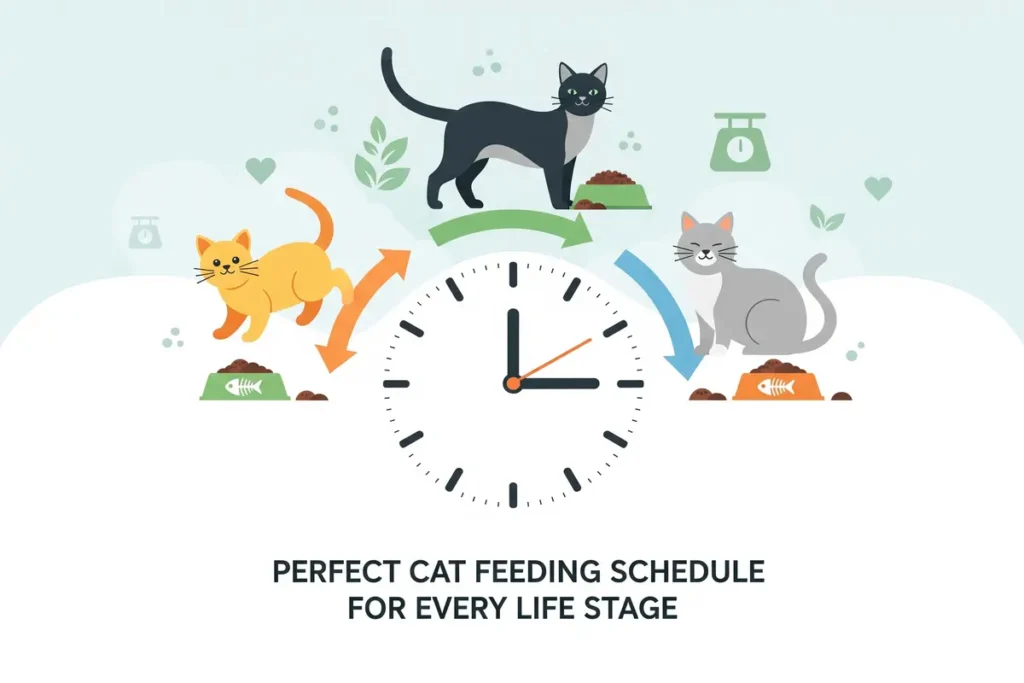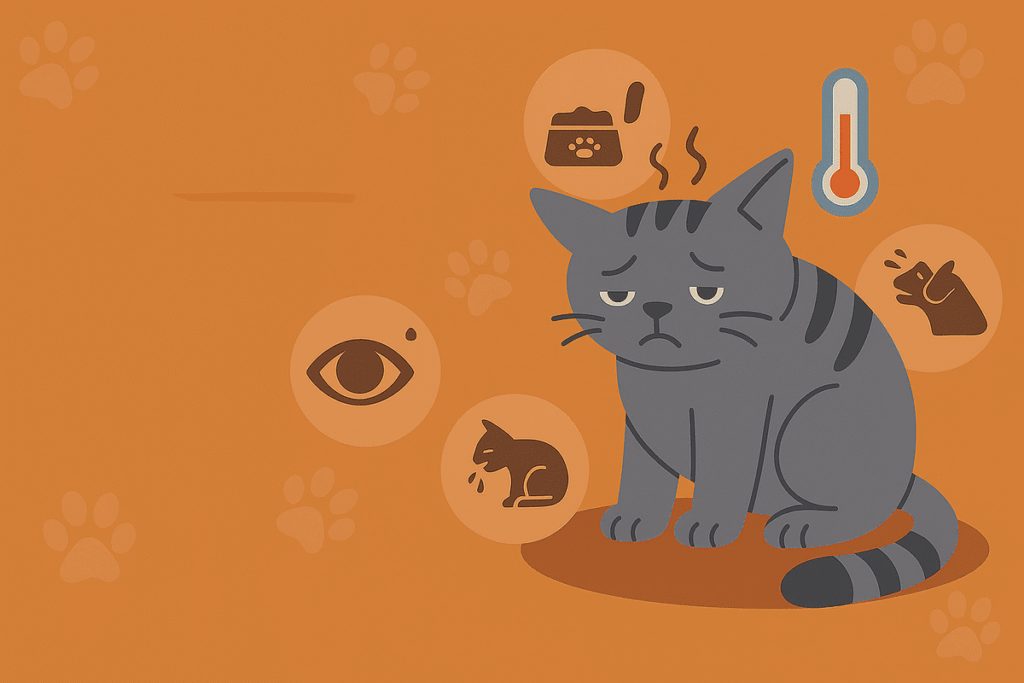Bringing home a cat is about more than just adding another pet to your family; it’s welcoming a new family member who is curious, clever, and often a little strange. If you’re a new cat parent, you may be asking yourself: what do I need to do to make sure my kitty is healthy and happy?
Well, there are a lot of little things you need to figure out, from making a nice cozy home for them to knowing what kind of playful things they want to do. This simple guide gives you the essentials and tips you need to be the perfect parental figure and is there to help you care for your new kitty friend, right from the first day. So, let’s learn how to play with a cat.
Essential Supplies for a New Cat
Before your new furry friend takes its first paw step into your home, having the precise necessities ready will make all the difference. Having a prepared home can reduce stress for both you and your cat and set the tone for a happy transition.
Bedding and Sleeping Areas
Cats are masters of napping, often sleeping for up to 16 hours a day. Make sure you provide your feline friend with a soft and warm bed in a quiet and draft-free corner of your home. It should feel safe and slightly sheltered especially at the adjustment stage.
Litter Boxes and Accessories
A litter box that is easy to expose is one of the most important supplies that you will need. The rule of thumb for litter boxes is one box per cat plus one extra box. For example, if you have one cat, ideally, you would have two litter boxes. Start with an unscented, clumping litter (as most cats prefer this type), and scoop the litter box at least once a day.
Place litter boxes in a quiet area with low traffic and away from the food and water area. It also helps to use a litter mat to catch errant granules and a scoop with a bin for easy cleanups.
Food and Water Bowls
Choose shallow, wide bowls made of stainless steel or ceramic because they are easy to clean and do not absorb smells the way plastic can. Cats frequently dislike when their whiskers touch the sides of deep bowls so shallow dishes are a much better fit.
Maintain food and water bowls in a specific location and avoid placing them near litter boxes. Refill with fresh water daily and wash the bowls often to help minimize bacterial growth.
Cat Trees and Scratching Posts
Cats naturally scratch for a number of reasons: to stretch, to mark their territory, and to maintain healthy claws. By providing cats with specific surfaces to scratch, you can avoid them scratching your furniture. Scratching surfaces should be placed where the cat likes to reserve (when lounging) or at an entry point (where guests intersect). Cats are natural climbers, and cat trees that incorporate climbing, resting, and scratching are ideal for stimulating a cat both mentally and physically.
Creating a Cat-Friendly Environment
Bringing a cat into your home is more than providing food and a litter box. You must also design an environment that makes your cat feel safe, comfortable, and mentally stimulated. Understanding how to make your home cat-friendly can lower anxiety for your cat, promote healthy behavior, and create trust between both of you.
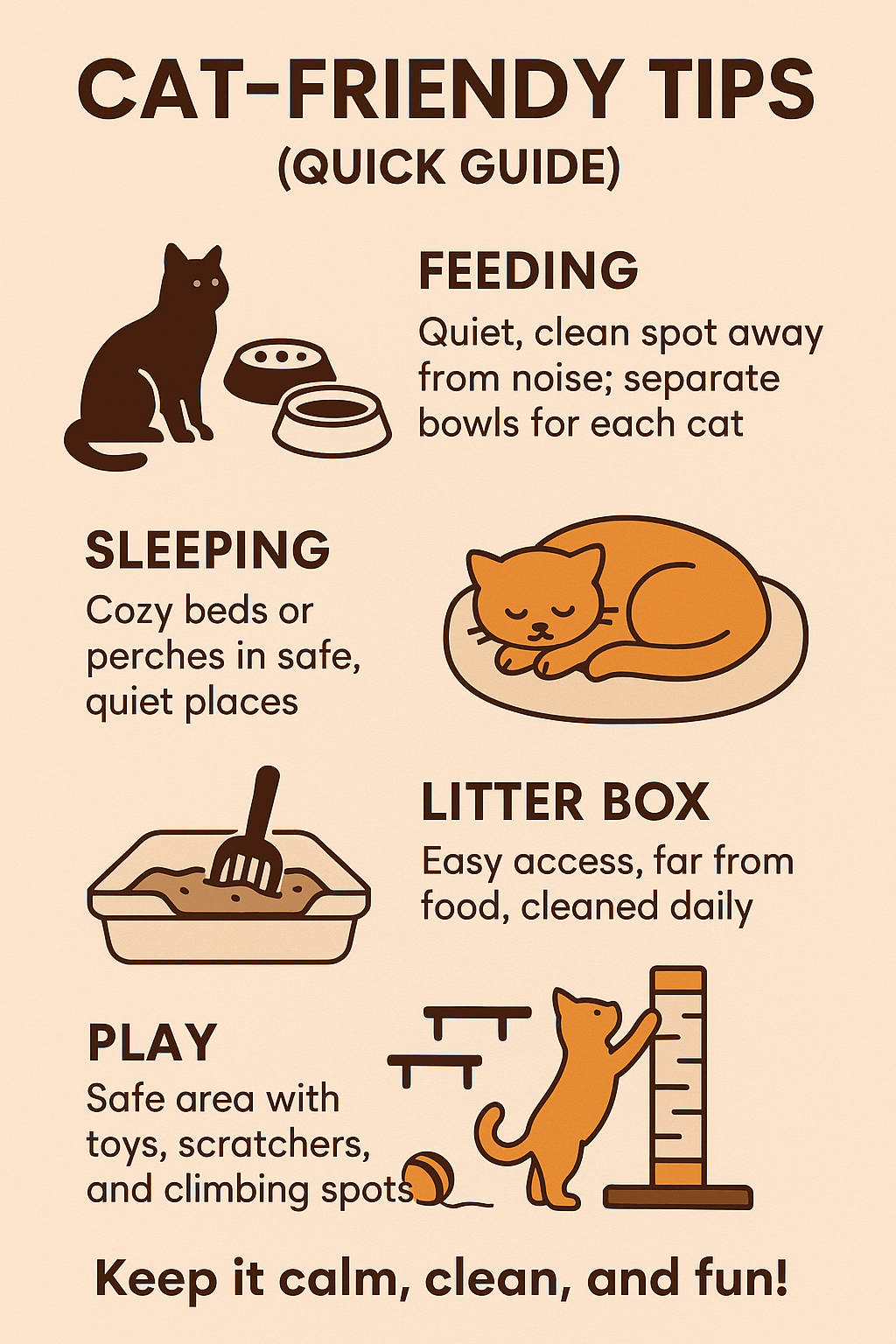
Designated Feeding Area
Cats appreciate regularity and privacy when they eat. Pick a low-traffic, calm place in your house to set your cat’s food and water bowls. Do not use locations near loud appliances, dishwashers, washing machines, etc., which make your cat apprehensive.
Make sure it is clean and does not have unpleasant smells. If you have multiple cats, make sure each cat has its feeding spot, keeping them from having to compete for food or ‘guard’ food from other cats.
Comfortable Resting Spaces
Cats love to sleep in safe, cozy places, usually high up or tucked away. The best way to provide a number of areas for your pet to rest and take advantage of their natural napping instincts is to give them ample space in which to do it. Provide padded cat beds, blankets, window perches, and soft places for them to curl up.
Clean and Accessible Litter Area
Where you put your litter box is important. Find a nice, quiet, low-traffic area with easy access at all times. Try to find a spot that is not in a high-traffic area or next to loud appliances. If you have multiple levels in your home, have a litter box on each level.
It is best if the litter box is not too close to the water or food dishes because cats do not like to eat close to where they go to the bathroom. You also need to clean the litter box every day and clean the litter out once a week to keep it fresh.
Fun and Safe Play Zones
Cats are naturally curious and playful animals, so enhancing their environment is necessary. Designate play areas with plenty of toys, scratching posts, climbing shelves, and tunnels, and even turn a cardboard box into a hiding place or a play house. Make sure the play area is safe and also make sure to avoid breakable items and secure heavy furniture that could tip over.
Exercise and Enrichment
Cats may have a reputation for being lazy, but they also need daily moderate to vigorous physical and mental activity to stay healthy and happy.
Indoor cats can suffer physical and behavioral issues without opportunities for enrichment and may accumulate excess weight with factors associated with boredom and lethargic behavior.
Keeping a mix of different types of toys, scratching areas, and mildly challenging activities will keep your cat active and stimulated.
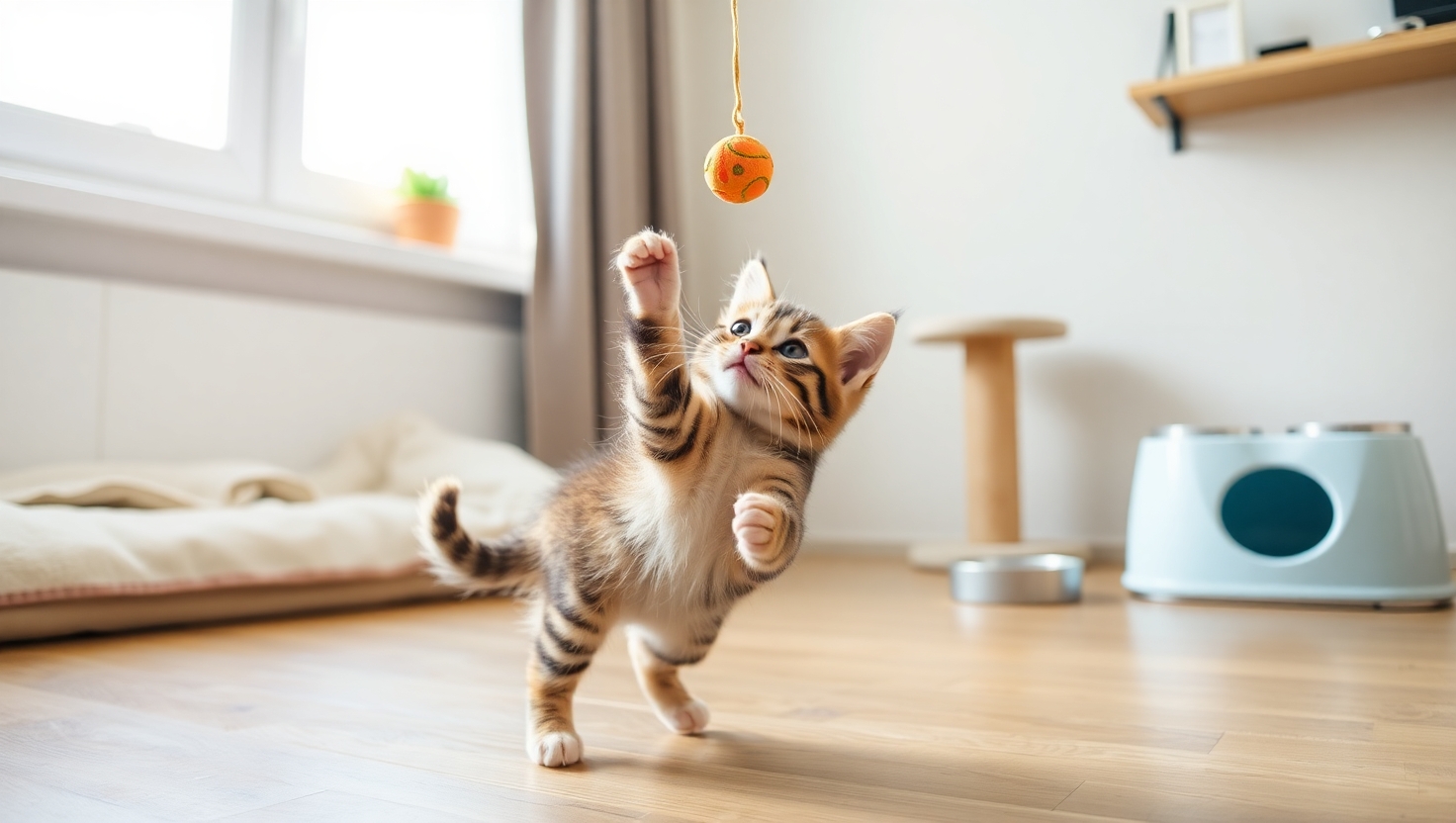
Toys and Playtime
Playtime is not only fun, it’s necessary! Interactive toys such as wand teasers, laser pointers, and feather toys are all ways to facilitate that instinctual feline desire to hunt. Toys and tools for solo play are also helpful. Balls with bells, crinkle toys, motorized mice, etc., will help a cat stay entertained when you are busy or not home.
Scratching Options
Scratching is a normal behavior for cats. Scratching helps them understand and designate territory, allows them to stretch muscles that they might not otherwise get to stretch, and helps maintain healthy claws. It’s important to provide your cat with scratching opportunities all over your house (e.g., scratching posts, scratchers made of cardboard, vertical scratching towers, or scratching ramps at angles).
Feeding Puzzles
Everyday life can also provide mental enrichment as well. Feeding puzzles and treat-dispensing toys can provide mental stimulation for cats by requiring them to think about their food and work for their food, as they would with hunting.
In addition to cognitive engagement, puzzles can slow down fast eaters, provide engagement, or even help with weight management. Start with the easiest puzzle feeder and then move on to more difficult ones as your cat learns. You can also hide small amounts of kibble around your house for further exploration and foraging.
Feeding and Nutrition
Feeding your cat is one of the key aspects of responsible pet ownership. A balanced diet supports immunity, energy, and overall health. Since feeding needs change as cats grow, see our full guide on the perfect cat feeding schedule for every life stage to create a routine that keeps your kitten, adult, or senior cat healthy.
Understanding a Cat’s Dietary Needs
Cats are obligate carnivores because they create their energy from the protein in animal meat. Their diet should vary in composition but be high in high-quality animal protein, moderate in fat, and low in carbohydrates. You should find cat food that specifies a real meat source first in the ingredient list, such as chicken, beef, or fish.
Avoid foods that are dominated by grain, meat by-products, or artificial additives. It is also important that cat food includes nutrients that cats cannot synthesize in their bodies (taurine, arachidonic acid, specific vitamins, etc.).
How and When to Feed a Cat
Feeding schedules change as the age and health of the feline changes.
- Kittens (under 6 months) require more frequent feedings, around 3 to 4 times daily, while their body is growing and needing constant fuel.
- Adult cats (1-7 years) are usually fed 2 times daily, around every twelve hours apart.
- Senior cats may need to change a feeding schedule based on health concerns, such as weight issues, dental issues, or chronic health conditions.
Consistency is Key, so feed your cat at the same time each day and always provide access to fresh, clean water.
Choosing the Right Food
There are a lot of different cat food options, like wet, dry, raw, and prescription formulas, which is why it is best to ask your vet if you are unsure what would be best considering the age, activity level, and health status of your cat.
- Wet food is high in water content, so it can help prevent dehydration and be beneficial for cats that are prone to urinary problems.
- Dry food (kibble) is easy to store and provides a more convenient option and may even provide dental health benefits by reducing tartar buildup.
- Combination Feeding: The third option of feeding your cat a mix of dry and wet food (combination feeding) is also very popular and, in theory, can provide you with the best aspects of both kinds of food.
Remember to be sure to look for complete and balanced formulas that are endorsed by an authority that certifies the approval of pet foods, such as the AAFCO (Association of American Feed Control Officials).
Grooming and Hygiene
Grooming is not just a way to keep your cat looking great; it is a component of their overall health. Grooming is important as it helps keep their skin healthy, controls shedding, makes sure they are not in excessive pain due to mats and can expose health problems at an early stage. Also, grooming is a great way to develop trust and bond with your cat.
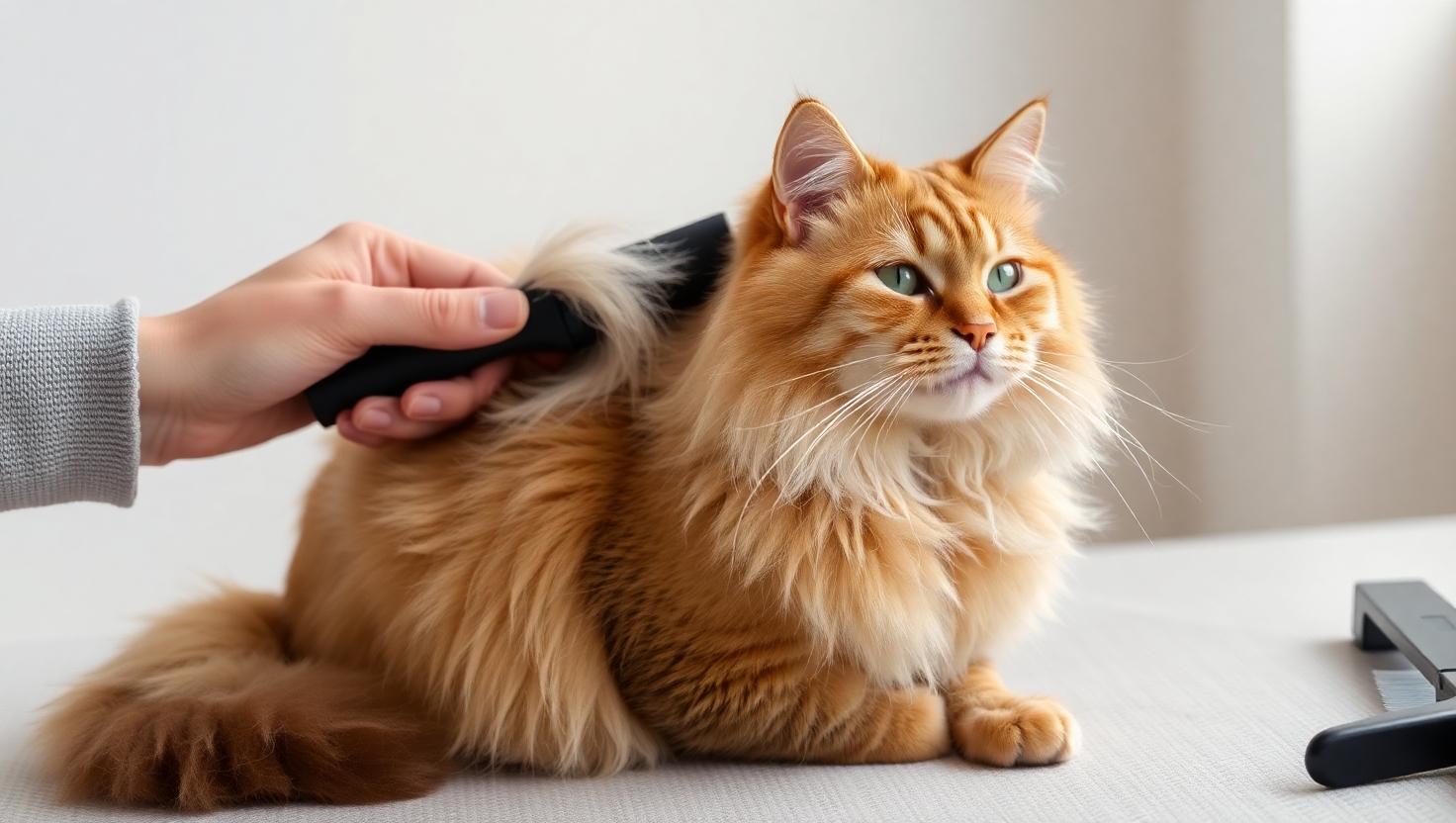
Brushing Techniques by Coat Type
The amount and brushing your cat gets will depend on the type of coat they have:
- Short-haired cats: Most of the time, brushing short-haired cats will just be once a week. Use a soft-bristled brush or grooming mitt to remove loose hairs and help reduce shedding!
- Long-haired cats: Breeds like Persians or Maine Coons need to be brushed daily to help prevent tangles and painful mats. Use a wide-toothed comb or a slicker brush, and be careful not to pull on their skin!
- Shedding cats: During seasonal changes, every cat will shed more, and it’ll be important to brush a few times per week to manage the loose fur (and hairballs!).
Brushing your cat in routine will not only reduce the mess in your home but will also stimulate blood circulation and help distribute natural oils across your cat’s skin for a healthy coat.
Litter Box Maintenance
Maintaining a clean litter box is the best way to maintain healthy hygiene for your cat, as well as freshness in your home.
- Scoop the litter box daily to remove and dispose of waste. Daily scooping promotes use and allows you to catch any strange behavior in your cat’s urine or feces.
- Change out the litter every week or more often, depending on the litter and your cat’s usage. After disposing of the litter, wash out the box with warm water and a mild soap! Always avoid strong disinfectants such as bleach and ammonia, or your cat will not use the box because of the scent.
- Always use an unscented, clumping litter box so that you can notice any important health changes in your cat’s urinary or defecation patterns and ensure better odor control.
Make sure your cat’s litter box is kept in a quiet, low-traffic area of your home, as opposed to a loud, highly populated containment space. If you have multiple cats, be sure you have a litter box for each cat, plus one extra.
Dental Care and Brushing
Dental care is vital for your cat to be healthy and happy, but often overlooked.
- Brush your cat’s teeth at least 2 – 3 times a week with a finger brush or small toothbrush and cat-safe toothpaste (never use human toothpaste because it’s bad for cats!).
- Be sure to introduce brushing slowly and reward your cat for positive experiences. Treats and chews can provide some additional support for brushing that may help minimize tartar accumulation.
- Regular veterinarian dental checkups of cats for dental health are important as well, especially for older cats/general breeds of cats susceptible to dental-related disease.
Bad breath, excessive drooling, and/or trouble eating are signs your cat may need to see the veterinarian for a dental assessment.
Health and Wellness
Your kitty’s overall health is dependent on more than just love and food; it requires consistent and preventive health care. Preventive healthcare, regular vet visits, and observant attention to behavior and changes are a large part of having a long and healthy life.
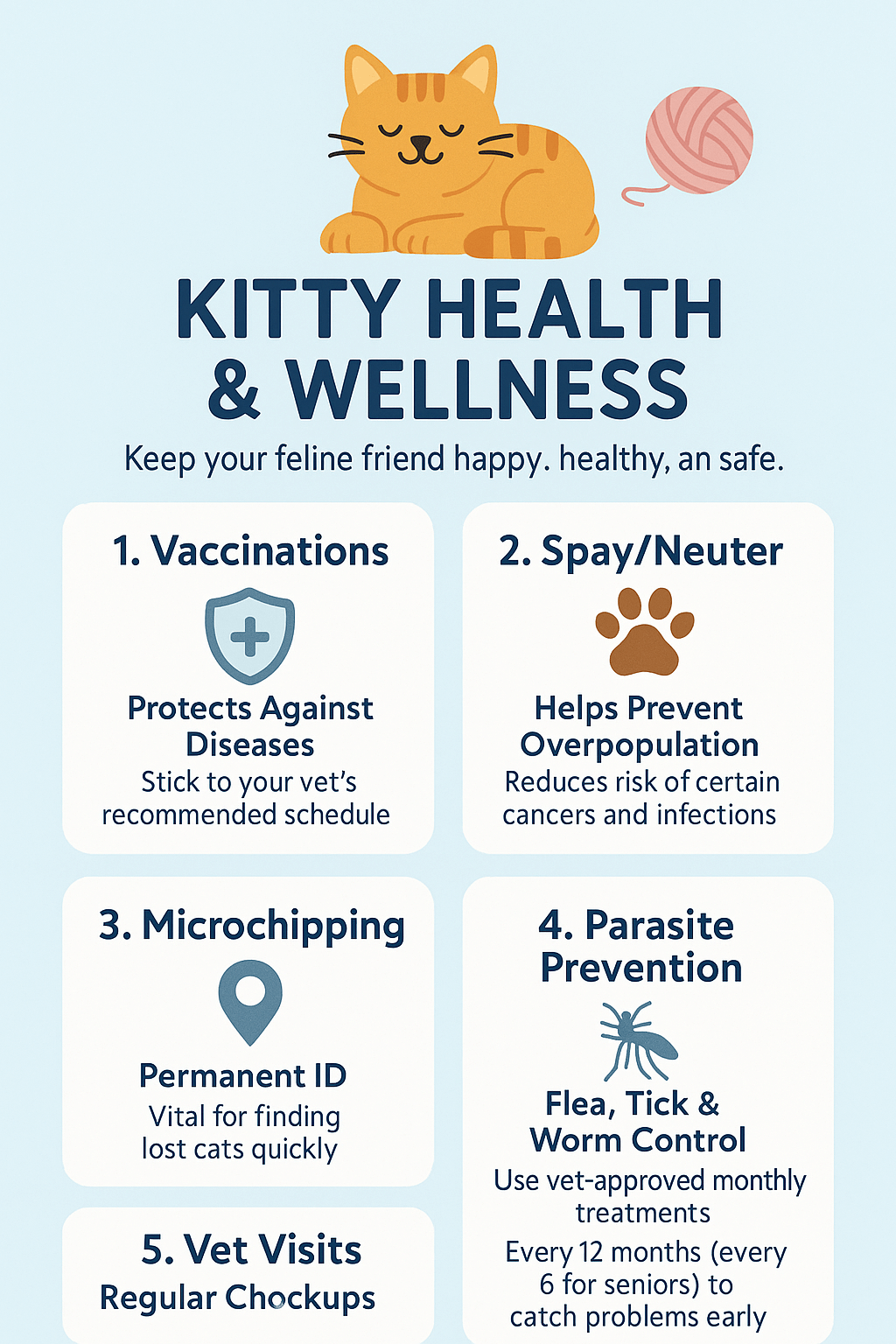
Vaccinations and Preventive Care
Vaccines are your cat’s best defense against serious disease.
- Core vaccines protect against feline panleukopenia, feline calicivirus, feline herpesvirus, and rabies.
- Non-core vaccines can be determined by lifestyle, such as the feline leukemia vaccine would be recommended for outdoor or multi-cat households.
- Your veterinarian will determine the initial vaccines and booster schedule in order to help Schedule programs to help keep immunity strong throughout your pet’s life.
Keeping up with vaccines not only protects your pet it also helps to prevent the spread of disease to other animals.
Neutering/Spaying
One of the easiest and most impactful ways to reduce pet overpopulation is to spay or neuter your cat. Spaying or neutering your cat will likely reduce behaviors such as (but not limited to) spraying, roaming, and aggression! Spaying or neutering your cat will also help to reduce the likelihood of certain cancers and reproductive issues. Most veterinarians recommend spaying/neutering at around 6 months of age.
Microchipping and Identification
Microchipping is a simple procedure that entails placing a chip about the size of a rice grain under your cat’s skin that has your contact information. Then, if your cat is lost, shelters and vets can scan the microchip and then contact you. It is a permanent and effective method of improving your chances of being reunited with your cat.
Parasite Prevention
Indoor cats can be affected by fleas, ticks, or worms. Regularly using vet-recommended products will allow you to keep your cat protected throughout the year. If you notice excessive scratching (flea vs itch related), diarrhea or constipation, hair loss, or bald patches, treat your cat sooner rather than later to prevent an infestation.
Routine Vet Visits
Annual vet checkups are crucial for keeping track of your cat’s health and catching any early signs of illness. Vet visits help keep your cat’s vaccinations up to date, as well as their dentals! If your cat is older, it may be a good idea for them to see the vet every 6 months.
Training and Behavior
Understanding cat behavior will help you formulate a respectful and sustainable relationship.

Getting Your Cat Settled
When you bring a new cat home, give the cat their space so it can explore and get its bearings. Limit it to a quiet room first, and gradually introduce them to more of the entire house. I don’t recommend forcing an interaction; it’s much more productive if the cat allows you to be a part of their space.
Reinforcing Behavior
A cat will respond well to positive reinforcement, so think of treats, toys, or affection. Reinforce the behaviors you would like to nourish, such as the litter box or the scratching post. I would not recommend yelling or punishing a cat – try calmly redirecting unwanted action.
Addressing Problems
Many behavior issues could have various definitions, whereas scratching the furniture, hiding, or avoiding the litter box are usually stress-related. If possible, find the source and remove it. If the problem is persistent, consult a vet or feline behaviorist.
Pet Insurance and Budget Planning
Planning your finances allows you to care for your cat through all of its life stages. Not to mention, it is a great feeling not to be financially stressed when caring for your feline companion.
Why is insurance important?
Cats can experience emergency care, surgery needs, or long-term treatments that can be costly! Pet insurance allows you to manage these costs better and you’ll be able to get the best care for your cat without having the added financial burden.
How do I choose a policy?
When searching for the best policy, look for a plan that is affordable and offers comprehensive coverage, including accidents, illnesses, and possibly even preventive care. Always double-check customer reviews and reimbursement policies. Also, ask your veterinarian for their recommended pet insurance plans!
Conclusion
Welcoming a cat into your home is a fun and exciting experience, but it also comes with commitments.
With some initial prep, consideration for your cat’s needs, and plenty of ongoing care, you will be on the road to a fun-filled, healthy life together.
There are lots of ways you can support your cat, like grooming care, nutrition-care, and healthcare will help to deepen the bond you will have together. With some patience and heaps of love, you will be a happy cat parent before you know it!
Caring for a kitty can be a thoughtful and loving adventure packed with snuggles, playing, and quiet time together.
After some preparation, a little patience, and lots of love, your new fur baby is sure to feel right at home and become an important part of your family.




